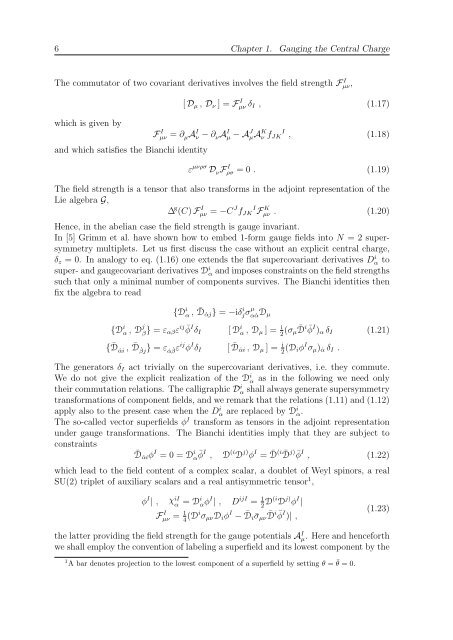N=2 Supersymmetric Gauge Theories with Nonpolynomial Interactions
N=2 Supersymmetric Gauge Theories with Nonpolynomial Interactions
N=2 Supersymmetric Gauge Theories with Nonpolynomial Interactions
You also want an ePaper? Increase the reach of your titles
YUMPU automatically turns print PDFs into web optimized ePapers that Google loves.
6 Chapter 1. Gauging the Central Charge<br />
The commutator of two covariant derivatives involves the field strength F I µν,<br />
which is given by<br />
and which satisfies the Bianchi identity<br />
[ Dµ , Dν ] = F I µν δI , (1.17)<br />
F I µν = ∂ µA I ν − ∂ νA I µ − A J µA K ν fJK I , (1.18)<br />
ε µνρσ D νF I ρσ = 0 . (1.19)<br />
The field strength is a tensor that also transforms in the adjoint representation of the<br />
Lie algebra G,<br />
∆ g (C) F I µν = −C J fJK I F K µν . (1.20)<br />
Hence, in the abelian case the field strength is gauge invariant.<br />
In [5] Grimm et al. have shown how to embed 1-form gauge fields into N = 2 supersymmetry<br />
multiplets. Let us first discuss the case <strong>with</strong>out an explicit central charge,<br />
δz = 0. In analogy to eq. (1.16) one extends the flat supercovariant derivatives D i α to<br />
super- and gaugecovariant derivatives D i α and imposes constraints on the field strengths<br />
such that only a minimal number of components survives. The Bianchi identities then<br />
fix the algebra to read<br />
{D i α , D j<br />
β } = εαβε ij ¯ φ I δI<br />
{ ¯ D ˙αi , ¯ D ˙ βj } = ε ˙α ˙ β ε ij φ I δI<br />
{D i α , ¯ D ˙αj} = −iδ i jσ µ<br />
α ˙α Dµ<br />
[ D i α , Dµ ] = i<br />
2 (σµ ¯ D i ¯ φ I )α δI<br />
[ ¯ D ˙αi , Dµ ] = i<br />
2 (Diφ I σµ) ˙α δI .<br />
(1.21)<br />
The generators δI act trivially on the supercovariant derivatives, i.e. they commute.<br />
We do not give the explicit realization of the D i α as in the following we need only<br />
their commutation relations. The calligraphic D i α shall always generate supersymmetry<br />
transformations of component fields, and we remark that the relations (1.11) and (1.12)<br />
apply also to the present case when the D i α are replaced by D i α.<br />
The so-called vector superfields φ I transform as tensors in the adjoint representation<br />
under gauge transformations. The Bianchi identities imply that they are subject to<br />
constraints<br />
¯D ˙αiφ I = 0 = D i α ¯ φ I , D (i D j) φ I = ¯ D (i ¯ D j) ¯ φ I , (1.22)<br />
which lead to the field content of a complex scalar, a doublet of Weyl spinors, a real<br />
SU(2) triplet of auxiliary scalars and a real antisymmetric tensor 1 ,<br />
φ I | , χ iI<br />
α = D i αφ I | , D ijI = 1<br />
2 D(i D j) φ I |<br />
F I µν = 1<br />
4 (Di σµνDiφ I − ¯ Di¯σµν ¯ D i ¯ φ I )| ,<br />
(1.23)<br />
the latter providing the field strength for the gauge potentials A I µ. Here and henceforth<br />
we shall employ the convention of labeling a superfield and its lowest component by the<br />
1 A bar denotes projection to the lowest component of a superfield by setting θ = ¯ θ = 0.

















